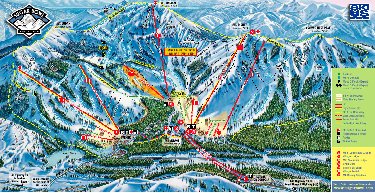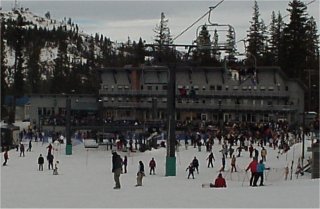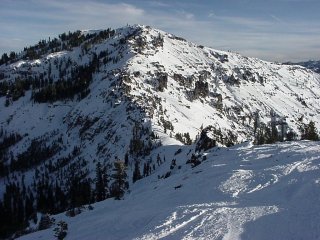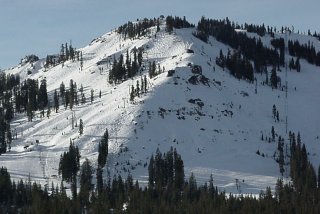Norden, CA – The alarm chirped at 6:30 AM. The kids, Jacquelin
14, and Jonathon, 10 rolled over into their respective pillows and buried their
heads in a lame attempt to shut out the noise and sleep in for a bit longer.
This otherwise compelling display of lameosity was, unfortunately, all for naught.
Dad, (yours truly) was already in the shower, the broiling water quickly re-energizing
my tired leg muscles for our final day on the slopes surrounding Lake Tahoe.
It had been a frighteningly whirlwind week of ripping the Tahoe area. Since
departing on our Southwest Air flight out of Detroit some seven days prior,
we had blanketed the slopes of five resorts during the past five days. Today
was to be the sixth. I was still psyched.
n
My uxorial partner, Briar, possibly
felt the same, but I couldn’t guarantee it. A steady week of motel sink sock-rinsing
and the continual grazing on pepperette sticks, granola bars and baby carrots
had, for some reason, caused her to begin obsessing about banal things such
as proper nutrition, laundry facilities, and other similar mundane issues.
Nevertheless, 7:30 AM saw us motoring westward from Tahoe City down I-80 toward
Donner Pass. Our destination: the legendary Sugar Bowl Resort.
|
Walt Disney, at right, visiting Sugar Bowl (photo courtesy |
Like nearby Alpine
Meadows, Sugar Bowl doesn’t lend itself to grandiose paper descriptions.
A rather modest 1,500 vertical foot rise, and a reasonably large but not overwhelming
1,500 acres of skiable terrain serviced by nine lifts . A base lodge setup
which, until very recently, required that you park your car way out at the access
road and ride an M&M-style gondola into the resort proper. Heck, even the
rumored typical clientele seemed rather tame, and its much-hyped historical
connection to Walt Disney sounded oh-so-precious.
Well, we’ve now skied Sugar Bowl.
For the record, I can advise that – all preconceptions notwithstanding – this
place kicks some big-time butt.
Like I implied above, we easterners
came to Tahoe for three reasons. Skiing. More skiing. And oh yeah, did I mention
… skiing? I suppose you could call us hardcore family skiers. Day Six,
as might be expected, found that theory being put to the test. However, our
anticipation began to increase as we turned south off I-80 onto the Sugar Bowl
access road and watched the depth of the snowbanks increase exponentially as
we drove further south. Sugar Bowl is located nearly smack dab in the apex
of Royal Gorge, a gap in the Sierra Nevadas which acts like a natural climactic
“snow funnel” for storms moving in across the western Sierra . The moisture-laden
air literally explodes into snowfall as the winds are forced up and over the
high peaks backing of Sugar Bowl Resort. As a result of this fortuitous placement,
Sugar Bowl vies with Kirkwood to the south in claiming
the highest average annual snowfall and greatest snowpack depth in the Tahoe
area (or, quite frankly, in all of North America). Not only that, many locals
swear that the snow quality at Sugar Bowl is superior to that at many of the
other local areas and is generally undeserving of the “Sierra Cement” tag.
|
Construction of the Disney Lift and Lodge, 1939 (photo
Digging out in 1938 (photo courtesy Sugar Bowl) Sugar Bowl trail map (click on image to open a full-sized |
Sugar Bowl’s ambiance for many years
could best be described as “stately”. The oldest of the Tahoe areas, it celebrated
its 60th anniversary in 1999-2000. It is a well known fact within
the ski community that Walt Disney had a hand in the developing and financing
of the original resort. Hence, the presence of Mount Disney, one of the renamed
mountains at the area. From its inception, Sugar Bowl was designed as a reclusive
and gracious getaway for the SoCal and Hollywood elite. However, old money being
what it was (and is) there is (and frankly never was) any overt evidence of
gaudy nouveau pretentiousness. Rather, the resort was designed in the vein
of what might best be described as a “secluded enclave”. Strikingly, there
has never been any automobile access to the original base area. Instead resort
patrons parked on the other side of the access road and ravine, and then rode
a quaint transfer gondola into the resort. This setup, with all its attendant
inefficiencies, remains in place to service the original lodge.
However, recognizing the necessity
of modernizing its access, the resort has invested heavily in new lifts and
facilities. The more or less continuous recent expansion culminated with the
opening of the Mt. Judah “main” base lodge complex, which is readily accessible
by wheeled vehicle. This easternmost mountain area at the resort is set up
for quick, efficient handling of crowds and associated transportation. Frankly,
pulling into the Mt. Judah parking lot was an experience in and of itself this
mid-March day . Vertiginous blower-cut walls of snow towered far overhead.
We had noticed that many of the dwellings on the road in had second floor entrance
doors built in A local indicated to us later that it saves on the digging-out
time during much of the winter.
Sugar Bowl consists of four peaks,
namely Mt. Judah, Mt. Lincoln, Mt. Disney, and Crow’s Nest Peak respectively,
running from east to west. While the general aspect of each mountain is north
facing, the peaks form a gigantic triangle with Mt. Lincoln recessed into its
central area and the others wrapping back to it. Accordingly, there are aspects
facing east through north through west. There is virtually no south-facing
terrain . There is a planned expansion farther to the west on Crow’s Nest Peak,
to be serviced by its own high speed quad as well as development of the backside
of Mt. Judah..
I had scheduled a lunch meeting with
Bill Hudson , the affable and enthusiastic sales and marketing director for
the resort. After picking up our tickets and booting up, we quickly found ourselves
in line at the Mt. Judah Express Quad. Unfortunately, six days of bluebird
skies and temperatures approaching 70 degrees had markedly affected the snow
surface. Despite continuing brilliant sunshine, the cool morning temperature
and resulted in snow conditions best resembling bulletproof porcelain. I quickly
recognized that the west-facing Mt. Judah slopes were likely the wrong place
to start that morning. Upon disembarking from the lift, my suspicions were
quickly confirmed. Coldstream, a mild blue square cruiser, skied like the Hahnenkamm.
|
Refreshingly, the Mt. Disney base lodge hasn’t changed |
Mt. Judah was the last area of the
resort to be developed. It was quite literally deemed necessary to do so to
overcome Sugar Bowl’s often intimidating reputation as an experts’ preserve.
To that end, the resort recently installed not one, but two high speed quads
in this area. The Mt. Judah Express serves a relatively large area of blue
cruisers and also functions as the resort’s terrain park/ half-pipe service
lift. The proximally situated but significantly shorter Jerome Hill Express
allows low intermediates an opportunity to experience a baker’s dozen (or more)
of mellow, picturesque runs. Reassembling at the bottom, we elected to traverse
over to the east-facing black diamond slopes of Mt. Disney, which we anticipated
were being softened by the morning sun.
If Sugar Bowl has a design flaw, it
is the fact that the Mt. Judah Express doesn’t provide access to the summit
ridge. This lift stops significantly short of the ridge line, leaving a hike
to the expert terrain off the top. I was later advised by Hudson that the lift
placement was specifically chosen to reduce the number of windhold days. Frankly,
I remain somewhat suspicious that accessing the steeper terrain located above
the lift would simply result in too many intermediates getting in over their
heads in an area marketed as the resort’s “cruise central”.
Access to the remainder of the mountain
can by gained by riding the adjacent Jerome Hill Express, or Sugar Bowl does
operate a very cool snowcat transfer shuttle between the Mt. Judah lift and
the old base. Accordingly, we threw our skis on its rack and headed via Bombardier
for Mt. Lincoln. Disembarking under the transfer gondola, the Mt. Lincoln base
lodge is an understated structure. True to my expectations, an inordinate number
of silver haired, fluid skiers cruised by all around us. I suspected many
of them had been skiing here for decades (and probably on the same skis). However,
I immediately noted that the general capability of the typical patron was at
a relatively high skill level. There is a reason for this, as some fifty percent
of Sugar Bowl’s terrain is rated black or blacker.
|
Mt. Lincoln from Mt. Disney (photo Marc Guido) |
With centrally-located Mt. Lincoln
looming overhead in the background, I noted that many of the steeper recesses
of the enticing area remained deep in shade. Given the snow conditions, that
would necessitate tackling the Silver Belt Quad later in the day after the sun’s
ray’s had worked their magic. Right now, I anticipated that a mistimed fall
would result in a scary slide for life – or worse. Mt. Lincoln was serviced
by a reasonably modern but slow quad chair, but for 2000-2001, the lift has
been upgraded to the Silver Belt Express, a high speed quad. This lift will
allow one to yo-yo approximately 1,400 vertical feet of seriously steep chutes
in large central bowl area, which is for the most part is directly in view of
the overhead chairlift audience. Given the frankly awesome terrain this lift
services and the fact that much of the time you will be plainly in view of
the chair-riders above, one is guaranteed to attract either the admiration or
the mirth of the crowd.
To the east of the Silver Belt Express
is a series of steep blue cruisers, most of which are manageable by all but
the most timid of intermediates. Directly below the chair lie a series of several
more or less parallel chutes, foremost of which is Steilhang Gully – another
immense, steep natural half-pipe. Depending on snow conditions, this area can
either function as an expert’s haven, or, on day like today, a test of the one’s
nerves. As an added bonus, most of the central Mt. Lincoln area remains shaded
for nearly the entire day, thus offering great powder snow preservation during
all but the warmest temperatures.
To the west of the Silver Belt Express
in the saddle between Mt. Lincoln and Mt. Disney lie the area’s true in-bounds
hero terrain, The ‘58 and the Palisades. As is the case with its similarly-named
runs at Squaw Valley, this is an the area of gnarly
chutes spilling eastward into the central bowl area. Much of this area requires
a cornice leap to enter and good skills to exit – it does not suffer fools gladly.
|
Mt. Disney today (photo Marc Guido) |
Mt. Disney looms to the west or right-hand
side when viewed from the base area. Serviced by its own high-speed quad, the
Disney Express, much of the expansive east and north facing terrain is also
rated single black diamond. Unlike much of Mt. Lincoln, most of the runs here
are navigable by competent intermediates in reasonable snow conditions. To
the west is another large area of long blue cruisers. The Mt. Disney area is
probably the most heavily skied area by the bulk of the resort’s clientele.
Also within Sugar Bowl’s permit area
and serviced by traversing west off either the Disney Express or the Crow’s
Nest Double lies the resort’s final area, Crow’s Nest Peak. Located well off
the beaten track, this area offers lightly gladed steeps and snowfields. In-the-know
locals realize that this is almost always the last area to track out after a
fresh powder dump. In fact, unskied lines can often be found here for days
after the last storm has moved through – eons after everything is completely
tracked up at Squaw Valley.
We elected to tackle the east-facing
steeps off Mt. Disney, which by now were softening nicely in the morning sun.
Runs like Disney’s Nose and Bacon’s Gully offer over a thousand verts of the
some of the most sustained black diamond fall-line cruising to be found in the
Tahoe area. As I indicated, the general level of skiing was proficient, yet
reserved. It’s as if there were signs posted reading “Hot Dogs need not apply”.
For a place as venerable as Sugar Bowl, it is also not surprising that the boarding
contingent was as small as anyplace we visited in the Tahoe area. I would estimate
that the skier to boarder ratio was less than four to one. That is not to say
that Sugar Bowl doesn’t welcome boarders – it does – but likely because boarding
culture simply came a bit later here than elsewhere in the Tahoe area.
We elected to grab lunch over at the
Mt. Judah main lodge. While the kids wolfed down heaping and reasonably priced
plates of fries, I broke free to chat with Hudson. About as laid back a Sales
and Marketing Manager as one will ever find, he regaled me with the resorts’s
history. He appeared genuinely proud that Sugar Bowl had erected the very first
chairlift in California. He impressed upon me that the resort’s raison d’etre
could be best described by fusing the concept of “big mountain resort” with
“down home tradition”. I advised Bill that the concept was amply in evidence.
For example, in keeping with the needs and desires of the resort’s knowledgeable
and “responsible” clientele, Sugar Bowl has long maintained an open boundary
policy. In fact, one can ski down the back of the resort all the way to Donner
Lake, and hitch a ride back at the bottom.
However, Hudson was equally proud to
discuss the resort’s recent growth both in infrastructure and market share.
Beside the recent substantial investment in base area and lift upgrades, immediate
future plans call for a new T-Bar running up the backside of Mt. Judah. As
well, at least one additional lift is planned for the area west of the Crow’s
Nest Chair, thus expanding the resort boundaries in that direction as well.
He also indicated that the resort is considering joining the Tahoe “Big Six”
in the very near future as a means of expanding its clientele beyond the ninety
percent presently arriving from within Northern California.
Despite Sugar Bowl’s reputation otherwise,
Hudson also took great pains to explain that the oft-dreaded snow closures and
chain restrictions occur only approximately ten days per season. The resort
also offers a plethora of affordable lift passes, including its long running
two-for-one deal on Wednesdays. Sugar Bowl also radically discounts ticket
prices for young adults to age 21 (unusual) and offers a twelve-and-under children’s
ticket for $10.00, which drops to $5.00 if the child is wearing a helmet (very
unusual and very welcome).
After the interview, Hudson expressed
his regret that business concerns did not provide for a break to show us his
various and sundry private stashes on the slopes. With the noon sunshine just
tickling the recesses of Mt. Lincoln, it was time to hit the Sisters and Steilhang
Gully. Riding up the Silver Belt lift is an experience in and of itself.
To the right is a vast curtain of steep chutes. Directly below, the keyhole
shaped gullies also give rise to a slight sense of foreboding. Hoots from the
chairs ahead announce the successful launch by another skier through the big
gully. Sweet.
Leaving from the top of
the lift, we shot over the lip and into the bowl area beneath. The tough snow
conditions made precise edging necessary, but the run was doable by any good
advanced rider. In fact, it was so good, several more samples were required.
Finally, at nearly 4:00 PM, I took some time to simply stand at the top of the
peak and savor one of the week’s last and best summit views. Too far from the
lake to view its aquamarine surface, one could still easily make out the backside
runs of Northstar-at-Tahoe, as well as those of Diamond Peak, in the far distance.
Gazing for a long moment, I savored a tremendous week of skiing that, unfortunately,
was soon to be consigned to memory and archived in this series of reviews.
In summary, this resort offered a terrific
conclusion to a fantastic week. I personally believe an appropriate moniker
for Sugar Bowl could be “Grand Dame of Tahoe”. Or, in the vernacular of the
unwashed, “Lady, you may be sixty, but you’re sure lookin’ great. I can’t keep
up at half your age”.







